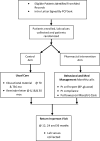Simultaneous Risk Factor Control Using Telehealth to slOw Progression of Diabetic Kidney Disease (STOP-DKD) study: Protocol and baseline characteristics of a randomized controlled trial
- PMID: 29649631
- PMCID: PMC5986182
- DOI: 10.1016/j.cct.2018.04.003
Simultaneous Risk Factor Control Using Telehealth to slOw Progression of Diabetic Kidney Disease (STOP-DKD) study: Protocol and baseline characteristics of a randomized controlled trial
Abstract
Diabetic kidney disease (DKD) is the leading cause of end-stage kidney disease (ESKD) in the United States. Multiple risk factors contribute to DKD development, yet few interventions target more than a single DKD risk factor at a time. This manuscript describes the study protocol, recruitment, and baseline participant characteristics for the Simultaneous Risk Factor Control Using Telehealth to slOw Progression of Diabetic Kidney Disease (STOP-DKD) study. The STOP-DKD study is a randomized controlled trial designed to evaluate the effectiveness of a multifactorial behavioral and medication management intervention to mitigate kidney function decline at 3 years compared to usual care. The intervention consists of up to 36 monthly educational modules delivered via telephone by a study pharmacist, home blood pressure monitoring, and medication management recommendations delivered electronically to primary care physicians. Patients seen at seven primary care clinics in North Carolina, with diabetes and [1] uncontrolled hypertension and [2] evidence of kidney dysfunction (albuminuria or reduced estimated glomerular filtration rate [eGFR]) were eligible to participate. Study recruitment completed in December 2014. Of the 281 participants randomized, mean age at baseline was 61.9; 52% were male, 56% were Black, and most were high school graduates (89%). Baseline co-morbidity was high- mean blood pressure was 134/76 mmHg, mean body mass index was 35.7 kg/m2, mean eGFR was 80.7 ml/min/1.73 m2, and mean glycated hemoglobin was 8.0%. Experiences of recruiting and implementing a comprehensive DKD program to individuals at high risk seen in the primary care setting are provided.
Trial registration: NCT01829256.
Keywords: Behavioral intervention; Chronic kidney disease; Diabetes; Hypertension; Pharmacist; Randomized controlled trial; Telehealth.
Copyright © 2018 Elsevier Inc. All rights reserved.
Figures
References
-
- Annual Data Report: Atlas of Chronic Kidney Disease and End-Stage Renal Disease in the United States. 2016 (Accessed 2017, at www.usrds.org/adr)
-
- Menke A, Casagrande S, Geiss L, Cowie CC. Prevalence of and Trends in Diabetes Among Adults in the United States, 1988-2012. JAMA. 2015;314:1021–9. - PubMed
Publication types
MeSH terms
Associated data
Grants and funding
LinkOut - more resources
Full Text Sources
Other Literature Sources
Medical
Research Materials
Miscellaneous



